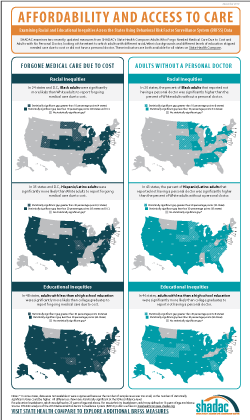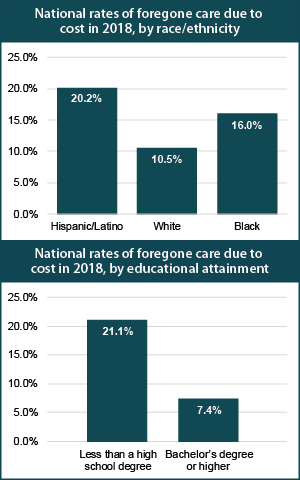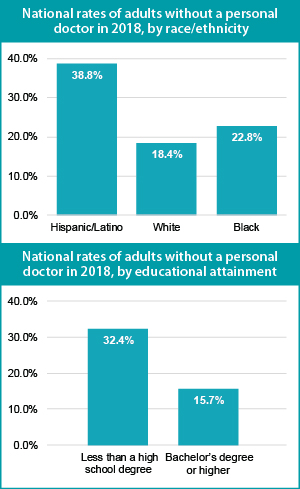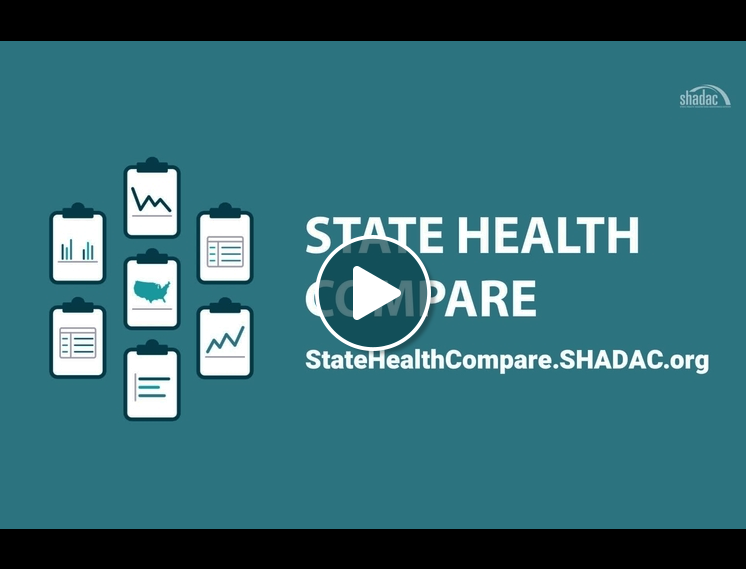Blog & News
Affordability and Access to Care in 2018: Examining Racial and Educational Inequities across the United States (Infographic)
December 17, 2019: The Centers for Medicare and Medicaid Services (CMS) recently reported that the cost of health care spending in the United States increased by 4.6 percent last year to reach an all-time high of approximately $3.6 trillion.1 This report comes amidst a number of other concerning health care cost-related trends, such as the largest single-year increase for single-coverage premiums in 2018 from $6,368 to $6,715 (5.4 percent) for workers enrolled in employer-sponsored insurance (ESI) and an increase in average household spending on health care (out of pocket expenses, cost-sharing for ESI, and payroll taxes for Medicare, etc.) rising to a record $1.04 trillion.2
The Centers for Medicare and Medicaid Services (CMS) recently reported that the cost of health care spending in the United States increased by 4.6 percent last year to reach an all-time high of approximately $3.6 trillion.1 This report comes amidst a number of other concerning health care cost-related trends, such as the largest single-year increase for single-coverage premiums in 2018 from $6,368 to $6,715 (5.4 percent) for workers enrolled in employer-sponsored insurance (ESI) and an increase in average household spending on health care (out of pocket expenses, cost-sharing for ESI, and payroll taxes for Medicare, etc.) rising to a record $1.04 trillion.2
Rising expenses such as these have contributed to the record number of Americans (25 percent) who reported in 2019 that either themselves or a family member skipped or delayed needed medical care due to cost, according to the results from a new Gallup poll released earlier this month.3
This post examines Americans’ access and ability to afford medical care, focusing on inequities related to race/ethnicity and education, and using two recently updated measures from SHADAC’s State Health Compare: Adults Who Forgo Needed Medical Care and Adults with No Personal Doctor. These measures come from a SHADAC analysis of 2018 data from the CDC’s Behavioral Risk Factor Surveillance System (BRFSS).
Racial and educational inequities persist in adults’ reported ability to afford needed medical care
 Significant inequities in adults’ ability to afford medical care by race/ethnicity emerged when we examined the updated data for 2018. At the national level, our analysis showed that Hispanic/Latino adults were nearly twice as likely as White adults to forgo needed medical care due to cost (20.2 percent versus 10.5 percent), and African Americans/Black adults were 1.5 times as likely to report forgoing care compared to White adults (16.0 percent versus 10.5 percent). Hispanic/Latino adults were also significantly more likely to report forgoing medical care than White adults in 35 states and D.C., and this gap was greater than 20 percentage points in Maryland (31.4 percent versus 7.4 percent) and Missouri (34.4 percent versus 11.1 percent). Black adults were significantly more likely to report going without care than White adults in 24 states and D.C., and this gap was greater than 10 percentage points in four states: Iowa (16.2 percentage points), North Dakota (15.5 percentage points), Utah (11.5 percentage points), and Minnesota (10.2 percentage points).
Significant inequities in adults’ ability to afford medical care by race/ethnicity emerged when we examined the updated data for 2018. At the national level, our analysis showed that Hispanic/Latino adults were nearly twice as likely as White adults to forgo needed medical care due to cost (20.2 percent versus 10.5 percent), and African Americans/Black adults were 1.5 times as likely to report forgoing care compared to White adults (16.0 percent versus 10.5 percent). Hispanic/Latino adults were also significantly more likely to report forgoing medical care than White adults in 35 states and D.C., and this gap was greater than 20 percentage points in Maryland (31.4 percent versus 7.4 percent) and Missouri (34.4 percent versus 11.1 percent). Black adults were significantly more likely to report going without care than White adults in 24 states and D.C., and this gap was greater than 10 percentage points in four states: Iowa (16.2 percentage points), North Dakota (15.5 percentage points), Utah (11.5 percentage points), and Minnesota (10.2 percentage points).
Nationwide, Americans with less than a high school degree were almost three times as likely to report going without needed medical care due to cost as compared to those with a bachelor’s degree (21.1 percent versus 7.4 percent) in 2018. Adults with less than a high school education were significantly more likely to report forgone care due to cost compared to adults with college degrees in 2018 in all but two states—Montana and Vermont—and in the District of Columbia (D.C.). For four states this gap was greater than 20 percentage points in 2018—Georgia (21.1 percentage points), Maryland (20.9 percentage points), Oklahoma (21.2 percentage points), and Virginia (21.2 percentage points).*
Racial/ethnic minorities and adults without a high school diploma less likely to have a personal doctor
 Nationally, Hispanic/Latino and Black adults were both significantly more likely to report not having a regular doctor as compared to their White counterparts. Our analysis revealed that Hispanic/Latino adults were more than twice as likely as White adults to report not having a personal doctor (38.8 percent versus 18.4 percent), and Black adults were nearly 25 percent more likely to report not having a personal doctor compared with White adults (22.8 percent versus 18.4 percent).*
Nationally, Hispanic/Latino and Black adults were both significantly more likely to report not having a regular doctor as compared to their White counterparts. Our analysis revealed that Hispanic/Latino adults were more than twice as likely as White adults to report not having a personal doctor (38.8 percent versus 18.4 percent), and Black adults were nearly 25 percent more likely to report not having a personal doctor compared with White adults (22.8 percent versus 18.4 percent).*
These inequities in access to care by race/ethnicity were present in a large majority of states. A significant gap between Hispanic/Latino and White adults with no personal doctor was present in 43 states, and Hispanic adults were more than three times as likely to report not having a personal doctor in five states (Connecticut, Maryland, Nebraska, New Jersey, and North Carolina). This significant gap also persisted between Black and White adults in 20 states, as we found that Black adults were more than twice as likely to not have a personal doctor in three states—Connecticut (22.8 percent versus 10.8 percent), Iowa (31.2 percent versus 15.1 percent), and Rhode Island (21.2 percent versus 9.9 percent).*
Nationally, adults with less than a high school degree were more than twice as likely to not have a regular doctor as those with an undergraduate degree or greater (32.4 percent versus 15.7 percent). This pattern was consistent across nearly the entire nation, as adults with less than a high school education were significantly more likely than college graduates to report not having a personal doctor in 46 states. The gap between less than high school graduates and college graduates was larger than 20 percentage points in eight states (California, Colorado, Georgia, Maryland, Nebraska, Nevada, New Jersey, and Utah).
Note
* Data were not available or were suppressed for some states because the number of sample cases was too small, so this number could be higher if data were available in all states. For education breakdowns, adults are defined as 25 years of age and above. For race/ethnicity breakdowns, adults are defined as 18 years of age and above. All differences are statistically significant at the 95% level.
Explore Additional BRFSS Data at State Health Compare
Visit State Health Compare to explore national and state-level estimates for the following measures that also come from the BRFSS:
Income Inequality
Sales of Opioid Painkillers
Adult Cancer Screenings
Chronic Disease Prevalence
Activities Limited due to Health Difficulty
Adult Obesity
Adult Binge Drinking
Adult Smoking
Adult E-Cigarette Use (New Measure)
State Health Compare also features a number of other indicator categories, including: health insurance coverage, cost of care, access to and utilization of care, care quality, health behaviors, health outcomes, and social determinants of health.
Related Reading
Now Available on State Health Compare: Eleven Updated Measures and One Brand New Measure
Educational Attainment and Access to Health Care: 50-State Analysis
Fifty-State Analysis Finds Lower Access to Care among Adults with Less Education
[1] Hartman, M., Martin, A.B., Benson, J., & Catlin, A. (2019, December 5). National Health Care Spending in 2018: Growth Driven by Accelerations in Medicare and Private Insurance Spending. HealthAffairs. [E-published ahead of print.] https://doi.org/10.1377/hlthaff.2019.01451
[2] State Health Access Data Assistance Center (SHADAC). (2019, August 14). State-level Trends in Employer-Sponsored Health Insurance, 2014-2018. Retrieved from https://www.shadac.org/ESIReport2019
Murad, Y. (2019, December 5). U.S Health Spending Rose to $3.6 Trillion in 2018, Propelled by Health Insurance Tax. Morning Consult. Retrieved from https://morningconsult.com/2019/12/05/u-s-health-spending-rose-to-3-6-trillion-in-2018-propelled-by-health-insurance-tax/
[3] Saad, L. (2019, December 9, 2019). More Americans Delaying Medical Treatment Due to Cost. Retrieved from https://news.gallup.com/poll/269138/americans-delaying-medical-treatment-due-cost.aspx
Publication
State and County Coverage Estimates, 2013-2017 ACS
Use this clickable map to see health insurance coverage estimates for each state and all counties for the pooled years 2013-2017.
Counties are searchable by bookmark in each state file.
2013-2017 American Community Survey (ACS) 5-Year Estimates:
Percent Uninsured, Total Civilian Noninstitutionalized Population by County
Click here to view estimates for Puerto Rico by municipio.
Click here to view a 50-state table of estimates.
These estimates come from the 5-year American Community Survey (ACS) via the U.S. Census Bureau’s American FactFinder (AFF) tool. The 5-year ACS is created by pooling together five years of ACS data to produce estimates for areas and subgroups with smaller populations.
About the ACS
The ACS is a household survey that began in 2005 and produces annually updated data on a variety of population characteristics, including health insurance coverage. In total, the ACS surveys approximately three million US households each year. An important feature of the ACS is that it includes a large enough sample for state‐level and sub‐state estimates.
The Census Bureau publishes 1-year estimates for areas with populations of 65,000 or more and 5-year estimates (covering 60 months) for all statistical, legal, and administrative entities.
The ACS began asking survey respondents about health insurance coverage during the 2008 calendar year. Specifically, the survey asks respondents about current coverage for each person in the respondent’s household. A person is categorized as “insured” if he or she has coverage at the point in time at which the survey is administered.
How Are these Estimates Different from the Estimates that SHADAC Publishes Using Census Bureau Micro-Data Files?
Two definitions used by the Census Bureau to generate the tabulations above differ from those that SHADAC uses to generate tabulations for State Health Compare. The definitional differences are as follows:
Family
- The Census Bureau defines a family as all related people in a household.
- SHADAC defines a family using a measure called the “Health Insurance Unit” (HIU), which includes all individuals who would likely be considered a family unit in determining eligibility for either private or public coverage.
- To learn more about the HIU, see SHADAC Brief #27, “Defining Family for Studies of Health Insurance Coverage.”
Family Income
- The Census Bureau determines family income as a percentage of the Federal Poverty Level (FPL), which is a definition of poverty used primarily for statistical purposes. For example, FPL is used to estimate the number of Americans living in poverty each year.
- SHADAC determines family income as a percentage of the U.S. Department of Health and Human Services’ Federal Poverty Guidelines (FPG), which is a measure used for administrative purposes. For example, FPG is used to determine eligibility for federal programs such as Medicaid and the Supplemental Nutrition Assistance Program (SNAP).
- To learn more about the difference between FPL and FPG, click here.
SHADAC Expertise
Data Analytics and Visualization
SHADAC is a nationally recognized research center in the collection and analysis of survey data and has long maintained specific expertise in the access and use of federal data, sought after by a variety of clients. SHADAC’s State Health Compare, supported by the Robert Wood Johnson Foundation, is a user-friendly and easily accessible online data tool for obtaining state-level estimates on a range of topics related to health and health care. Additionally, SHADAC researchers are experienced in effective visualization in the form of maps, infographics, state profiles, and chartbooks, which can play a critical role in the dissemination of policy-relevant data and communication of data implications.
SHADAC's State Health Compare
 Analysts and policymakers can use State Health Compare to view measures of insurance coverage, access, cost, utilization, and outcomes—as well as social and economic measures related to health. State Health Compare allows users to compare these measures across states and look at trends over time through user-generated maps, bar charts, trend lines, and tables. Users can also explore these measures within states by characteristics (e.g., age, race/ethnicity, and education level). State Health Compare hosts more than 45 measures and estimates are available for timespans ranging from 4 to 21 years - drawing from 15 different sources. Click here for a full list of measures, data sources, and data years currently available, and check out our short tutorial video to learn tips and tricks for using State Health Compare!
Analysts and policymakers can use State Health Compare to view measures of insurance coverage, access, cost, utilization, and outcomes—as well as social and economic measures related to health. State Health Compare allows users to compare these measures across states and look at trends over time through user-generated maps, bar charts, trend lines, and tables. Users can also explore these measures within states by characteristics (e.g., age, race/ethnicity, and education level). State Health Compare hosts more than 45 measures and estimates are available for timespans ranging from 4 to 21 years - drawing from 15 different sources. Click here for a full list of measures, data sources, and data years currently available, and check out our short tutorial video to learn tips and tricks for using State Health Compare!
On-Demand Analysis of Federal Survey Data
On a task-by-task basis, SHADAC conducts quantitative analyses for the Medicaid and CHIP Payment and Access Commission (MACPAC) using a broad array of federal survey data, including the American Community Survey (ACS), National Ambulatory Medical Care Survey (NAMCS), National Electronic Health Records Survey (NEHRS), National Health Interview Survey (NHIS), National Survey of Children's Health (NSCH), National Survey on Drug Use and Health (NSDUH), Medical Expenditure Panel Survey (MEPS), Pregnancy Risk Assessment Monitoring System (PRAMS), and the Survey of Income and Program Participation (SIPP), among others. As part of this work, SHADAC assists MACPAC in scaling work to meet their information needs, producing sound estimates, and developing documentation that supports the reproducibility of results over time. Key SHADAC staff execute diverse statistical methods ranging from simple descriptive statistics and t-tests to multivariate logistic regression and maintain Special Sworn Status to facilitate access and use of restricted data at the Minnesota Census Research Data Center (MnRDC). Our work has contributed to a wide range of products, including: 2022 MACStats: Medicaid and CHIP Data Book; Experiences in Lesbian Gay Bisexual Transgender Medicaid Beneficiaries (Brief); Experiences in Accessing Care by Race and Ethnicity (Brief); June 2021 Report to Congress on Medicaid and CHIP; Health Needs of Adults Involved in the Criminal Justice System (Brief); Rural and Urban Health Care (Brief); Adolescents’ Use of Behavioral Health Services (Brief); Pregnant Women and Medicaid (Brief).
IPUMS Health Surveys (2006-Present)
Since the early 2000s, SHADAC’s Director has led an effort to harmonize the data and documentation produced by the NHIS, which was expanded in 2016 to include the MEPS. The IPUMS Health Survey project allows users to create free, individual-level customized data extracts for analysis to support time trend analysis through consistent variable coding and production of publically available microdata. This work involves the creation of more than 2,000 integrated variables with comprehensive metadata, and through this work SHADAC has developed expertise and a deep understanding of the publically available NHIS and MEPS data, supporting our work using NHIS restricted data in the RDC.
Examples of SHADAC data visualization products
50-State Snapshots and Profiles - 50-state snapshots and profiles provide an overview of individual state-level data for all 50 states and the District of Columbia on specialized topics, such as health insurance coverage or health care access and affordability. Snapshots and profiles often include not only data for the state overall, but also breakdowns by year, by demographic groups, and national or state-to-state comparison.
Room to Grow: Inequities in Children's Health Insurance Coverage
Measuring State-level Disparities in Unhealthy Days
A State-level Look at Flu Vaccination Rates among Key Population Subgroups
Infographics - SHADAC produces a wide variety of infographics as a clear and concise way to convey complex data analysis in an engaging visual format. Infographics often accompany shorter blog posts and deeper analyses, and can also stand alone as part of communication or public engagement with broader audiences.
CPS ASEC: 2020 vs. 2021: National-level Changes in Uninsurance Rates
2021 Employer-Sponsored Insurance Access and Cost in the United States
2020 NHIS: State vs. National Estimates of Health Insurance Coverage
Interactive Visualizations - SHADAC has expanded our portfolio of interactive data visualizations to provide users with an opportunity to easily and visually sort and compare data across states.
State Survey Research Activity
Selected Health Equity Activity in State Medicaid Programs
Explore more of SHADAC’s data visualization products here.










